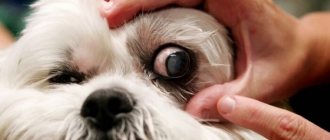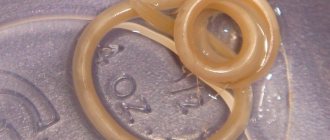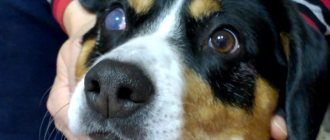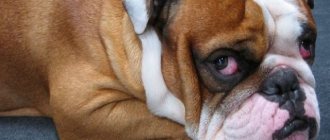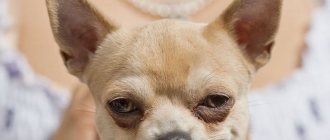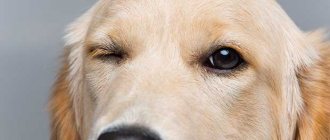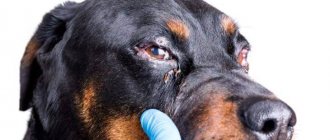How would you react if you woke up in the morning and your dog had a cherry eye? For a responsible pet owner, this will obviously cause a bit of shock followed by a lot of worry. If you are completely unaware of this condition, it is best to call your veterinarian to find out what it is. The first thing you will hear will be described as "cherry eye" and you will also be told not to panic as this is not a life-threatening condition.
However, a red blob sticking out of your dog's eye is definitely confusing, and as a pet owner, you should make an effort to understand what causes cherry eye in a dog and what steps you can take to deal with it.
So what is cherry eye?
Medically called “third eyelid adenoma,” it is a condition in which the lacrimal gland located on the third eyelid of a dog’s eye bulges. It appears as a red blob from the inner corner of the eye near the dog's nose and seems quite painful, although this does not explain why your dog may not complain about it.
© shutterstock
A closer examination of a dog's eye would reveal that, unlike the human eye, it consists of three eyelids. Among them, the upper and lower eyelid are always visible, while the third eyelid remains hidden from view and serves the dual purpose of protecting the eye from dirt particles and keeping it moist. This third eyelid is also home to the tear gland, and when it pops out from the corner of the eye as a red blob, the condition is called cherry eye .
Although this disease in itself may not be life-threatening, it deserves a certain degree of attention because there have been cases where it has become infectious. If you notice that your dog is constantly scratching his eye or there is thick or watery discharge in the area, it is time to visit the veterinarian. Another characteristic of cherry eye is that it is never limited to one eye—sooner or later the other eye is bound to burst.
What causes cherry eye in dogs?
Despite extensive research, the exact cause of cherry eye has yet to be determined and remains one of the unsolved mysteries of the canine world. A number of conclusions have been drawn as to why this occurs, and the reasons range from physiological to genetic in nature.
A generally accepted fact about cherry eye is that it occurs when the connective tissue that attaches the tear gland to the eye weakens. When this happens, the lacrimal gland loses its anchor and moves out of its place, thus protruding above the white part of the eye like a cherry. However, what weakens connective tissue still eludes experts, and this is where speculation arises.
The occurrence of cherry eye is also associated with genetic factors, which lead experts to believe that some dog breeds are more vulnerable to the condition than others. Most flat-faced, wide-mouthed breeds such as beagles, bulldogs, pugs, poodles, etc. have been found to have weak eye tissues and hence are considered more prone to cherry eye. But this distinction is not sacrosanct, and this condition can affect any dog, regardless of its breed.
Discharge from the eyes of a dog: causes and methods of treatment
Excessive tearfulness of the animal's eyes is a protective mechanism aimed at cleansing the organ and removing pathogenic microorganisms.
Discharge from the eyes of a dog mainly indicates diseases of the visual and internal organs. Some eye diseases can lead to complete blindness of the animal.
Let's look at in what cases is discharge from the eyes in dogs normal? Why might dogs have purulent discharge from their eyes? How to treat diseases of the organs of vision?
When it's ok
If you see brown discharge from your dog's eyes, don't panic. This is normal for many breeds. It is associated with the structural features of the skull and the shape of the muzzle: sagging cheeks, bulging eyes, flat muzzles.
These marks are especially noticeable in dogs with light fur. Such problems arise due to improper functioning of the tear ducts. Brown discharge from a dog's eyes has the same origin as discharge from a person's eyes after sleep.
They take on a brown color due to exposure to yeast and bacteria.
In any case, the animal must be taken for a preventive appointment with a doctor to make sure that nothing threatens its visual organs. However, brown marks under the eyes are often not a symptom of any disease. This is simply a characteristic feature of this breed.
If your pet has such a problem, every day you need to remove marks under the eyes with a damp, clean cloth. There is no need to use any chemicals as they may get into your eyes. In some cases, the doctor may prescribe special drops to solve this problem.
Symptoms of the disease
Excessive production of tears in breeds for which this is considered uncharacteristic is the first sign of vision problems in a pet. The eyes begin to leak, wet tracks and dried crusts appear at their corners. White discharge from a dog's eyes indicates serious pathogenic processes in the body.
The dog may begin to scratch its eyes and rub its head against surrounding objects. The eyelids become inflamed and swollen. The whites turn red and the animal’s vision decreases. Problems with orientation in space may begin.
If not treated in a timely manner, it is also possible to have an increase in body temperature, refusal to eat, apathy and drowsiness.
A pale veil may be visible on the eye, there is more and more discharge from the eye, and an unpleasant odor emanates from it.
Treatment methods depend on the cause of the dog's eye discharge. To accurately diagnose the disease, you must consult a doctor.
Sometimes, discharge from the eyes can be a symptom of a viral infection. In this case, any delay could cost the animal its life. Infections that can cause eye infection:
- enteritis;
- adenovirus;
- carnivore plague;
- kennel cough;
- hepatitis.
With a viral infection, the dog may have diarrhea and vomiting, the animal refuses to eat, and becomes apathetic. In this case, the pet’s condition deteriorates rapidly. The dog must be taken to the vet immediately, otherwise the animal may die.
Viruses can also affect the condition of the visual organs. Green discharge from a dog's eyes is often accompanied by salmonella. Animals that come into close contact with livestock are at risk. Salmonella is accompanied by elevated body temperature, vomiting blood, diarrhea, and apathetic state. In this case, only a doctor can help.
Mechanical damage
A small scratch or grain of dust is enough to cause damage to the mucous membrane of the eye. While walking, stones, dust, branches, grass and even thorns can get into your dog's eyes. Usually in this case, discharge is observed only from one eye.
Due to infection in the wound, suppuration occurs, and white discharge is observed from the dog’s eye. More often, it is thanks to tears that the eye itself is cleared of foreign objects. But if suppuration begins, the dog definitely needs human help. Discharge from a dog's eyes can occur due to a head injury.
They also often happen after the dog has swam in a pond. The cause may be sand and algae floating in the water.
Purulent discharge from the eyes of a dog is possible when the upper or lower eyelid is inverted. In this case, the eyelashes and fur scratch the mucous membrane, which leads to serious damage. As a result, ulcers form on the surface; in more severe cases, the animal may lose an eye.
Allergic reaction
The result of exposure to an allergen on the body can be increased tearing of the eyes. In particularly serious cases, white discharge from the dog's eyes is observed. Anything can be an allergen:
- plant pollen;
- individual feed components;
- household chemicals;
- medicines;
- flea drops and collar;
- dust.
Signs of an allergy may include:
- sneezing and coughing;
- itching and baldness of some areas of the skin;
- discharge from the eyes and nose of the dog;
- swollen lips, nose and paw pads.
If left untreated, bronchial asthma and pulmonary edema are possible. Damage from exposure to an allergen accumulates in the body. Therefore, the reaction to it becomes more severe over time, which can lead to suffocation and death of the animal.
Problems with internal organs
Diseases of the internal organs can cause white discharge from the dog's eyes. Particular attention should be paid to the health of puppies and older dogs, whose immunity is often weakened. To determine the cause, sometimes it is necessary to conduct a full examination of the animal.
Many chronic diseases also cause vision problems during periods of exacerbation. The cause of increased tearing can be benign and malignant formations in the area of the lacrimal glands or in the animal’s brain.
Common Cherry Eye Symptoms
Besides the characteristic symptom of protrusion of the round and red lacrimal gland, other common symptoms associated with cherry eye include:
- Squinting of the eye, especially if the dog is in pain;
- Dry eyes due to swelling and bulging of the lacrimal gland;
- In some cases, cherry eye may be accompanied by swelling in the surrounding areas, but this does not always happen;
- A discharge—watery or thick—from the affected eye, indicating infection of the lacrimal gland as a result of exposure;
- Visual impairment.
While at first it's just a cherry on top of your dog's eye, the situation can quickly get worse if ignored. A dry eye can cause a dog to scratch it in an attempt to relieve irritation, and this can lead to more serious problems such as bleeding and injury. Instead of waiting for the condition to worsen, you should take your dog to the vet immediately and explore possible treatment options.
© shutterstock
Causes of disease in dogs
The first cause of illness in many dogs is poor nutrition. Diseases are also caused by violation of living conditions. Take your dog to the veterinarian as often as possible to prevent illness in time. Give your dog the necessary vaccinations every year; if you don’t, there may be dire consequences.
Cocker spaniel diseases and prevention
A common illness in dogs is the common cold. In order to protect your dog from this disease, be sure to close the windows to avoid drafts.
But if your dog still gets sick, consult a doctor; if treated in a timely manner, your dog will only need a few injections, and if you’re lucky, a cough medicine such as marshmallow root will suffice.
But pay attention to the fact that the mixtures do not contain alcohol; children’s ones are best suited.
Ear prevention is also not at all difficult. Clean your dog's ears from a very young age, because even as a puppy, he should get used to this procedure. Usually all dogs love to have their ears cleaned. This must be done using a cotton swab pre-moistened in a three percent solution of boric alcohol.
Clean at least once every five days. There are also exercises for the dog’s ears; the owner twists the spaniel’s ears with his hands and easily wraps them around his fingers. This exercise is good for your dog's eardrums and ear cartilage.
If your cocker spaniel gets sick and has problems with his eyes, be sure to take preventative measures. Remove all accumulated mucus, dust and tears from the corners of your eyes. It is advisable to carry out this procedure every day. To wipe your eyes, use cotton swabs soaked in a solution of boric acid; you can also use special wipes for cleaning your eyes.
If your dog has conjunctivitis, wipe its eyes with a soft cotton swab, moistening it in baby albucid beforehand. If you don’t have the necessary components on hand, you can wipe your eyes with a swab soaked in very strong tea.
Cherry eye treatment
Cherry eye itself should not be a concern for pet owners, but there are a number of secondary problems that it can create that should be considered. The longer cherry eye remains in place, the higher the chance of more serious complications occurring, and this is the reason why treatment should be sought as early as possible.
Problems solved by timely treatment:
- Returning the lacrimal gland to its rightful place and restoring the third eyelid in the process;
- Minimize the likelihood of discharge from the affected eye;
- Protect your eyes from injury;
- Prevent irritation and dry eyes, which cause discomfort for the dog;
- Allows the lacrimal gland to resume its function of maintaining eye moisture.
Treatment options for ridding your dog of cherry eye have evolved over the years and range from using gentle topical products to invasive procedures such as surgery. There was a time in the past when the only treatment was to remove the tear gland, causing the eye to become permanently dry. This method was then abandoned because it not only removed moisture from the eye, but also made the organ susceptible to infection, especially variants of conjunctivitis. As a result, the dog had to be taken to the vet many more times to be treated for dry eye and infection.
Gradually, more treatment options have emerged, which are discussed as follows:
- Current products . They need to be applied to the surrounding area, where their purpose is to reduce swelling and inflammation. At the same time, they are also designed to protect the eye from secondary infections that may occur if the lacrimal gland is exposed. However, topical medications are only intended to provide temporary relief and do not cure cherry eye. They simply serve as short-term pain relief until a more specific treatment plan can be made.
- Operation . Instead of removing the tear gland and subjecting the dog to a lifetime of desiccation, experts recommend surgical repositioning, which returns the eyelid to its original position through a small procedure. There are several methods that can be used to achieve this result, and the choice of method depends on the ease of implementation and the comfort of the dog, as well as its owner.
A dog owner should be aware that choosing a surgical procedure is by no means a guarantee that cherry eye will not recur in either eye in the future. Since there are no preventative measures, you will need to treat your dog every time this occurs.
Inflammation of the third eyelid in dogs - treatment
It is worth repeating once again that you should seek professional treatment for suspected third eyelid prolapse in dogs as soon as possible. The pathology itself is not particularly dangerous for the animal, but the consequences that may follow it are very long, expensive and difficult to treat in the future.
Treatment of third eyelid adenoma in dogs is impossible at home. To date, there are no drugs, tools or techniques that could help an animal without the participation of a veterinarian.
Main direction in therapy
When providing professional assistance, the doctor will pursue the following goals:
- An attempt to restore not only the appearance, but also the physiological functions of the third eyelid structures as much as possible.
- Reduction of pathological discharge from the affected eye.
- Minimize irritation and damage to the cornea, including conjunctival tissue.
- Reducing the risk of developing secondary bacterial infections.
- Eliminate discomfort for the animal during the recovery period after surgery.
Treatment Options
It is worth noting that non-surgical treatment methods for third eyelid prolapse in dogs, as a rule, do not bring the desired result. Any attempts to put the organ back in its place in almost one hundred percent of cases will lead to its re-prolapse, and very often - a few days after assistance is provided. To effectively help an animal, surgical excision of the area of inflamed lacrimal glands, which also cannot be treated, is necessary. After removing the affected tissue, surgical reposition of the third eyelid is performed - moving it into place with parallel suturing. It is worth noting that after such treatment, relapses of “cherry eye” do not occur, and there are no external traces visible to the naked eye.
However, this approach also has its disadvantages. Removal of the lacrimal glands will lead to a lifelong lack of hydration of the ocular surface, which ultimately significantly increases the risk of developing keratoconjunctivitis sicca, or, as this disease is also called, dry eye syndrome. This pathology does not arise immediately, as a rule, only after several years, as the dog’s body ages and its resistant and compensatory forces decrease.
Forecast
If an animal has a unilateral lesion, the owner should understand that surgical correction of the affected area will not reduce the risk of developing a similar condition in the other eye, where the disease is most likely to recur. Today, there are no treatment or prevention methods that can radically or indirectly prevent the development of third eyelid prolapse in dogs.
In general, surgical treatment for third eyelid adenoma in dogs is usually very effective, but if the tear glands are extensively removed, the animal may require daily care for the rest of its life in the form of eye drops applied several times a day.
If our readers have any questions about the causes, symptoms and treatment of inflammation of the third eyelid in dogs, you can ask them in the comments to this article, or
Owners often turn to a veterinary ophthalmologist because of an enlarged and reddened third eyelid in dogs (the so-called “cherry eye”). This pathology is often called “inflammation of the third eyelid”, “adenoma of the third eyelid”.
Adenoma (benign tumor of the glandular epithelium) of the lacrimal gland of the third eyelid occurs as an independent disease, but, according to statistics, it accounts for about 5% of all neoplasms of the auxiliary apparatus of the eye. This is an extremely rare disease in dogs and occurs in animals over 6 years of age.
Cherry eye syndrome is hyperplasia and prolapse of the lacrimal gland of the third eyelid.
The third eyelid gland is an accessory lacrimal gland. It is usually not visible, but its role in moisturizing the eyeball is great. When it is displaced (prolapsed), it looks like a rounded red swelling between the cornea and the third eyelid.
Prolapse of the third eyelid gland occurs primarily in young dogs (6 weeks to 2 years). Predisposed are American Cocker Spaniels, English Bulldogs, Beagles, Shar-Peis, Newfoundlands, Bloodhounds, Lhasa Apso, Miniature Poodles, and Shih Tzus.
Forecast
Regarding the surgical procedure, the prognosis is very positive, considering that after the operation the eye returned to its normal state. While removal of the gland entails the use of eye drops on your dog for the rest of his life, the repositioning will ensure that the lacrimal gland resumes its function of lubricating the eye as it once did.
After surgery, you must ensure that your dog is properly rested to recover, and he will need to wear an Elizabethan collar throughout the recovery phase to protect him from scratches and friction.
Once the cherry eye has been treated, now is the time for you as a pet owner to start monitoring the other eye to ensure the same problem does not occur. Sometimes pet owners choose to have surgery on both eyes at the same time as a preventative measure, but this is the exception rather than the rule.
Despite the surgery, there is a 20% chance that the gland will slip out and stick to your dog's face again. When this happens, everything returns to normal for you, as well as for your beloved dog.
Author of the article : Olivia Williams.
